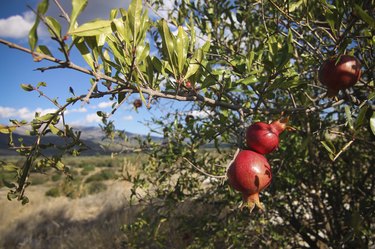
A long-time favorite in mild climates, pomegranates (Punica granatum) are small to large deciduous bushes that can be trained as trees. Native to the Mediterranean, cultivars include those grown for their edible fruits as well as ornamental varieties. Pomegranate flowers can be large and showy, appearing branches in spring and summer, depending on the variety. Flower colors include orange, red, yellow, white and variegated. Pomegranates generally grow in U.S. Department of Agriculture plant hardiness zones 8 through 11, depending on the cultivar.
Pomegranate Fruit Characteristics
Video of the Day
The round pomegranate fruits range from yellow to pink, red and burgundy. Breaking open the leathery skin of a pomegranate fruit reveals sparkling, pulp-coated seeds. The flavor and juice comes from the pulp, which is a specialized seed coating, called an aril. The pulp can be red, burgundy, purple, pink or whitish. The white, usually bitter membranes divide the arils into several different sections within each fruit.
Video of the Day
Flavorful Pomegranates
The taste of edible pomegranate fruits depends on the variety. For a delicious, almost winelike flavor, "Wonderful" (Punica granatum "Wonderful") grows in USDA zones 7 through 11. It reaches 10 feet tall and wide, bearing bright red-orange summer flowers and dark red fruits in fall.
Ripening two weeks earlier is "Early Wonderful" (Punica granatum "Early Wonderful"), which also grows in USDA zones 7 through 11. "Parfianka" (Punica granatum "Parfianka") has soft, small seeds with pink arils. The large, bright red fruit is rated as fully flavored and juicy. It grows in USDA zones 7 through 10.
Sweet-Tasting Pomegranates
Many pomegranate fruits have a balance of sweet and tart tastes. If you prefer a sweeter pomegranate, try "Utah Sweet" (Punica granatum "Utah Sweet"). The pinkish fruits have sweet, pink flesh and its flowers are pink to orange. Growing 20 to 30 feet tall, "Utah Sweet" grows in USDA zones 6 through 10.
Another sweet variety, "Azadi" (Punica granatum "Azadi") fruits are peach-colored with pink arils. It grows from 5 to 10 feet tall in USDA zones 8 through 10.
Pomegranates With Colorful Pulp
If what's important to you is a richly colored juice and aril, as well as taste, look for pomegranate varieties with deep red to purple arils. "Ambrosia" (Punica granatum "Ambrosia") has purple arils inside pale pink fruits, yielding purple juice with a tart and sweet taste. The fruits are large, about three times that of "Wonderful." Hardy in USDA zones 7 through 10, this cultivar grows to 10 feet tall.
For a dark red aril and juice paired with a tan and red to pink speckled fruit, consider the fragrantly sweet and spicy "Sirenevyi" (Punica granatum "Sirenevyi"), introduced from Turkmenistan. It grows in USDA zones 7 through 10 and also reaches 10 feet tall.
Ornamental Varieties
Grown for their decorative flowers and colorful yellow fall foliage, ornamental pomegranates have single or double flowers. Some ornamental pomegranates don't bear fruit, while others have conspicuous fruit that's not tasty. One of the best pomegranates for decorative value with full, double, pink to apricot flowers on a 10-foot-tall bush, "Toyru-Shibori" (Punica granatum "Toru-Shibori") grows in USDA zones 7 through 10.
Another showy Japanese variety, the white, double flowers of "Haku-Botan" (Punica granatum "Haku-Boten") are followed by white, sour fruit. Growing to 10 feet tall and wide in USDA zones 8 through 10, flowers appear in spring and summer.
- Texas A&M AgriLife Extension: Pomegranates
- Texas A&M University: Aggie Horticulture: The Southern Garden: Pomegranate Punica Granatum
- California Rare Fruit Growers: Pomegranate
- The Incredible Pomegranate; Richard Ashton
- Missouri Botanical Garden: Punica Granatum
- Monrovia: Fruiting Pomegranate
- Clemson University Cooperative Extension: Pomegranate